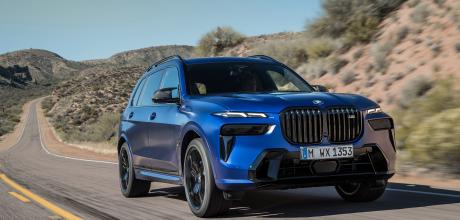2024 BMW X7 M60i xDrive G07 LCI
BMW’s biggest SUV has received an extensive mid-life update to help it keep pace with the brand-new 7 Series G70 – and maintain profitability.
First Drive: G07 X7 LCI
We get behind the wheel of the facelifted X7.
Profitability: that’s what cars such as the BMW X7 are all about. SUVs, in general, are more than a little responsible for the company’s healthy bottom line, as evidenced by the existence of X models 1 through 7 (not to mention the range-topping XM that goes on sale in 2023). And, while there are likely to be more than a few dyed-in-the-wool BMW enthusiasts reading this magazine and grumbling about the change in the manufacturer’s line-up in recent years, they’re equally likely to be delighted that BMW can afford to invest so much money in its more sporting models and the ever-expanding reach of the M division.
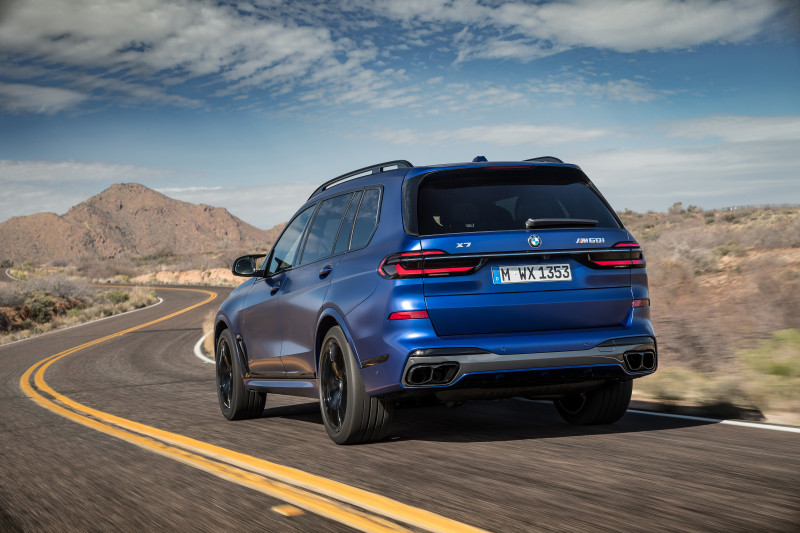
With all that in mind, at the introduction of the updated X7 in America, the company openly admitted that one of the driving forces behind such a significant overhaul of its largest SUV – just three years after it was first introduced, remember – was profitability. In short, it makes a lot of money out of this vehicle, and it wants to keep doing so. The location of the international media drives for the new model should be of no surprise, either, as the vast majority of sales of the X7 are in North America, followed by China and Korea. Germany, the X7’s biggest market in Europe, takes just 2% of annual X7 production, so the UK’s opinion of the big SUV is of very little relevance to its gestation and evolution.
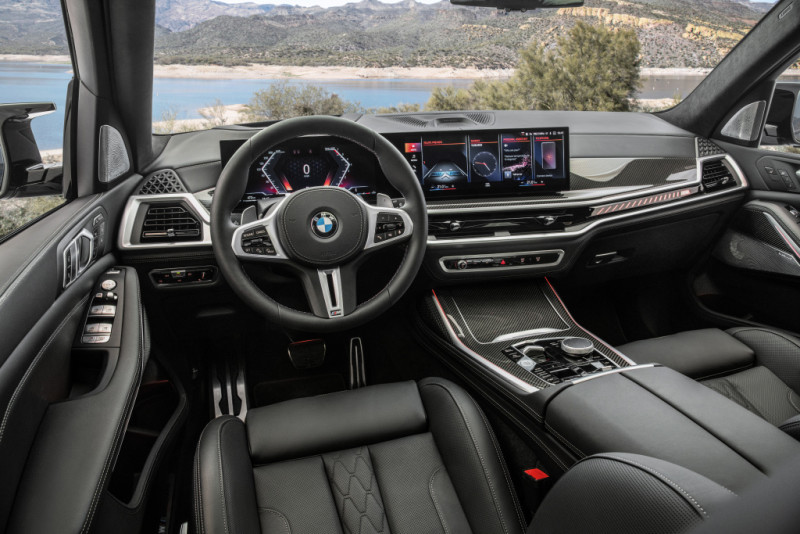
BMW took the opportunity of the launch event to remind the assembled guests that its sole American factory, at Spartanburg in South Carolina, is its biggest and busiest in the world. It should be no surprise to hear that it specialises in BMW’s X SUVs, and it is still undergoing considerable expansion, in line with the success of those vehicles around the globe. The core recipe of the X7 has not changed in its LCI. It is a luxury SUV, in concept, a BMW 7 Series on stilts. Nonetheless, its tall body doesn’t only afford the X7’s occupants a better view out, but it’s also a versatile car. By default, it has seven seats in three rows, and there’s room for adults in all of the seats. Many buyers take BMW up on the option to replace the middle bench of three seats with two full-size chairs, reducing the seating capacity by one but upping the luxury quotient considerably – reinforcing the luxury car side of the equation instead of the family-carrying one. For the update, the cabin gains upgraded seats, equipment and material choices, including the option of synthetic material in place of the supple leather usually found on the chairs, dashboard and doors. It seems that more and more luxury car buyers are turning to vegan products and demanding an alternative to cowhide for upholstery.
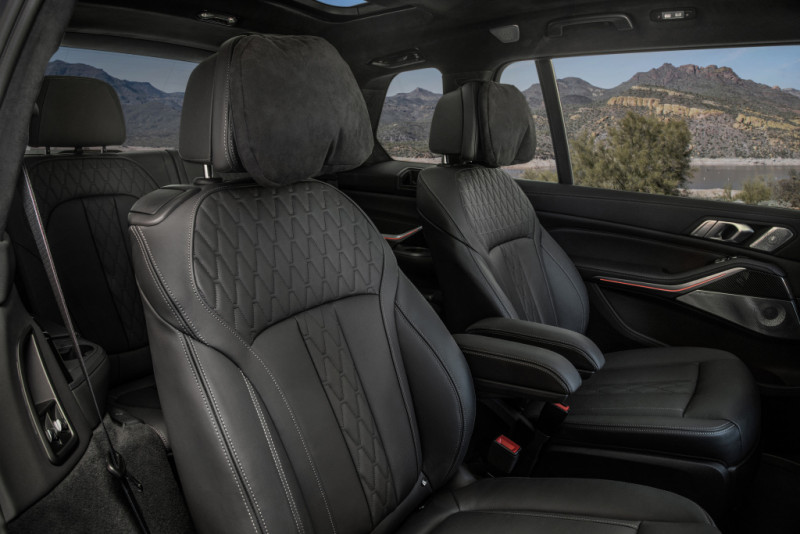
The most obvious update to the X7’s interior, however, is the introduction of BMW’s latest software and electronic architecture under the umbrella of BMW Operating System 8.0. This is visually represented by the new curved display setup – as first seen on the i4 and iX and now slowly permeating through the rest of the BMW line-up – incorporating digital instrumentation and a large touchscreen mounted seamlessly behind an aesthetically pleasing, single curved surface. There’s a wealth of connectivity functionality and lots of new driver assistance technology built in, too. It’s a little overwhelming at first, but owners will soon get used to it – and while we disapprove of the movement of the air conditioning controls to the screen, we’re glad to see that BMW has retained the iDrive rotary controller between the front seats. That’s far safer and quicker to use on the move than the touchscreen itself.
On the subject of moving, BMW claims to have considerably overhauled the X7’s three engines, though the updates aren’t immediately obvious as the changes were designed around improved efficiency and cleanliness rather than performance. A powertrain engineer at the event explained that the focus was on preparing the engines for the next round of emissions legislation, so a lot of repackaging and redesign of the exhaust systems was carried out.
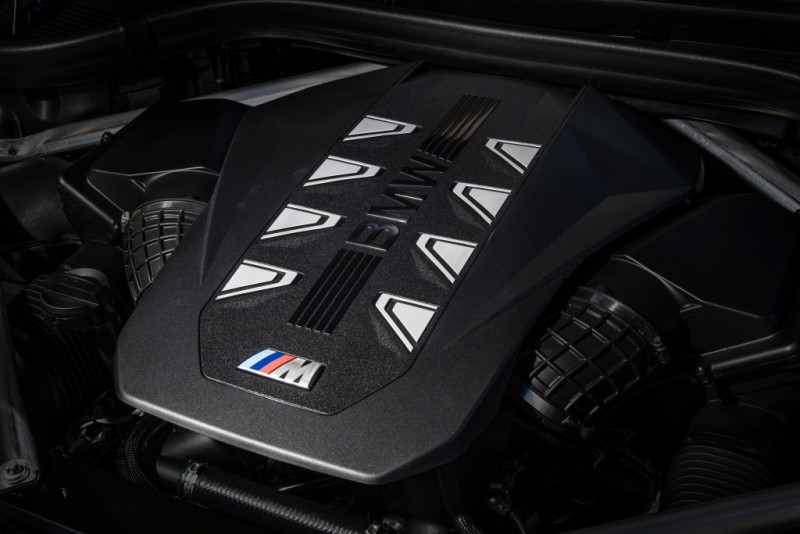
The most evident update comes in the form of the addition of a 48-volt mild-hybrid system to each of the three engines. Within the new eight-speed automatic gearbox is a small electric motor-generator that replaces the starting motor and can aid the engine in terms of response at low speeds while operating as a generator of electricity when decelerating to charge a supplementary 48-volt battery under the bonnet. In the entry-level petrol model, the xDrive40i, the electric motor can move the car on its own at really low speeds – while parking, for example – for short periods, so it gets an acoustic pedestrian warning system. This isn’t in the other versions.
That 40i model is the most popular globally and has had a performance boost for a start, now maxing out at 380hp and 383lb ft – up 47hp and 51lb ft, respectively. The electric motor in the gearbox can boost peak output torque to 398lb ft incidentally, helping drop the 0-62mph time by a full half second to an admirable 5.8 seconds. There’s a huge amount of new stuff on the engine that contributes to the increased outputs while also making it cleaner and more efficient. As ever, it’s a silky-smooth 3.0- litre straight-six engine that is all but inaudible most of the time, and it then emits a sporty sound when its considerable performance is called upon. If you have deeper pockets and a desire for even more oomph, the range-topping X7 M60i comes with an M-developed, twin-turbocharged, 4.4-litre V8 petrol engine that puts out 530hp. This is the S68 unit, and though the M60i is the first BMW to go into production with it under the bonnet, it’s also set to power the XM hybrid – and likely to form the basis for the next M5 powertrain. That peak power figure is backed up by a healthy 553lb ft of torque, helping the big X7 hit 62mph from rest in just 4.7 seconds – while bellowing through its sports exhaust as only an M-developed V8 can. Oddly, the vital stats of this engine are a little different to those of its predecessor in the X7 M50i, using the old N63 engine, but, the new one can pass future emissions legislation while maintaining the same level of performance.
In fairness, who needs more in a vehicle of this size? Both petrol models feel at home on the wide roads of America, delivering effortless performance with some personality. Indeed, the X7’s considerable bulk is disguised somewhat in that environment, where it’s nowhere near the largest vehicle around. The standard air suspension and double-glazing work together to provide for a cosseting and comfortable experience, while the adaptive damping keeps firm control of the body’s movements, so it never feels vague in the way that some luxury cars can.
To date, most British buyers have eschewed the petrol variants in place of the sole diesel–badged xDrive40d. Like all models, it gets four-wheel drive and an eight-speed automatic gearbox as standard, and it’s brilliant for towing heavy loads, if not quite as cultured as the petrol-powered alternatives. As part of the update, BMW’s engineers spent a little time on this engine too, replacing the aluminium pistons for steel to enable higher combustion pressures and upgrading the common-rail direct fuel injection system. All that was done in the name of fuel economy and emissions, so the peak outputs are unchanged at 340hp and 516lb ft, though the mild-hybrid system can up the latter to 531lb ft at times.
It would have seemed sensible to introduce a plugin hybrid version of the X7 at this stage, perhaps using the six-cylinder powertrain of the excellent X5 xDrive45e. However, insiders confirmed that packaging the hybrid system into the X7 would have required the deletion of the third row of seats, which was not deemed acceptable to buyers of this car. Speaking of which, we do wonder what they think of the X7’s new appearance. The original model was criticised by some for its use of an oversized radiator grille, but that car now looks quite ordinary when parked next to the new model. The grille remains – and it’s now illuminated as standard – but the rest of the front end has been restyled to align the car with the new 7 Series and the XM, too.
Central to the design is a split-headlight arrangement, where the main headlamps – using matrix LED technology – are mounted lower down and separated from the slender LED daytime running lamps and indicators by a section of bodywork. Air vents on the outer edges of the ‘bumper’ are also integrated with the lights to give the X7 a distinctive appearance. It won’t be to all tastes, that’s for sure, and the paint colour has a significant influence on the overall effect of the changes. Apparently, the rear lights are new as well, but nobody will notice as they’ll be too busy gawping at the nose. BMW has also introduced a 23” alloy wheel option for the first time, and while the bigger rims help disguise the size of the car, we can confirm they also ruin the ride quality – despite the best efforts of the air suspension.
In the UK, the updated X7 starts at £86,475 for the xDrive40d in Excellence specification. The xDrive40i is only £1230 more, and both can be paired with the sportier-looking M Sport trim level.
Topping the line-up is the £109,935 M60i tested here. The X7 has always had the luxury to tempt buyers out of their 7 Series, and though the new Seven – especially as the all-electric i7 – is more technologically advanced than ever, the gap between it and the X7 is no chasm. Against that, the X7 looks like a bit of a bargain, as the cheapest 7 Series is the i7, at £110,545, or £117,555 for a plug-in hybrid. Those are high prices by any measure, admittedly, though quite competitive with the car’s biggest rivals – the Mercedes GLS and the new Range Rover. And those are the vehicles you need to compare the X7 to, not the X5, which is all too often used as a reference point for it. Despite the strong pricing, you can be sure that BMW is making a handsome profit out of each and every one. And long may it be so.
22” wheels come fitted as standard, but 23s are available as an option. The cabin is as luxurious as you’d expect and now features BMW’s new OS 8.0 4.4-litre twin-turbo S68 makes 530hp and features 48-volt mild-hybrid assistance.
TECHNICAL DATA 2024 BMW X7 M60i G07
- ENGINE: 4.4-litre twin-turbo V8 S68B44 with 48-volt mild-hybrid assistance
- TRANSMISSION: Eight-speed Steptronic Sport automatic ZF8HP
- MAX POWER: 530hp @ 5500-6000rpm
- MAX TORQUE: 553lb ft @ 1800-4600rpm
- 0-62MPH: 4.7 seconds
- TOP SPEED: 155mph
- ECONOMY: 21.9-23.2mpg
- EMISSIONS (CO2): 292-276g/km
- PRICE (OTR): £109,935


